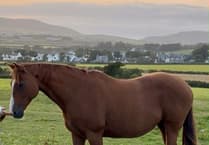There have been many slogans seeking to help in encouraging visitors to our island.
Without doubt, one of the best and most successful was ‘Come abroad to the Isle of Man’.
Imagine the idea for those people who worked in a mundane job in a sometimes challenging city environment of ‘going abroad’.
And remember, at this time, this suggestion predated the popular ‘package holidays’, which revolutionised tourism from the 1960s onwards.
The idea of the adventure of an add-on boat journey to a location not far from home was a real attraction for those in such situations.
Whoever thought up this slogan at the Isle of Man Publicity Board, which predated the Tourist Board, certainly came up with a winner!
Other slogans that have shown foresight include ‘A thousand years – a thousand welcomes’ in 1979, when we celebrated the millennium of our historic parliament, Tynwald, and welcomed more than 600,000 visitors with a range of events throughout the year.
In 1986, ‘It’s our differences that make the difference’ obviously targeted those unique elements, many of which were gifts from previous generations over the centuries and clearly closer in time to our Victorian and Edwardian predecessors.
I will refer to this again shortly. In 1989, the chosen slogan was ‘You’ll look forward to going back’, targeting those who had perhaps visited during the very busy years, or their families, prior to the package holiday boom.
Honesty is also important, and I recall the Young and Rubicam campaign which I think overpromised, whereas as an island our infrastructure and other elements lagged behind our competition at that time.
Another campaign from 1983 was ‘The inexpensive island holiday’.
Now, for the 10 years I was Minister of Tourism, the most regular negative comment was the cost of access, so that promotion would have struggled to meet its offer.
Back to ‘It’s our differences that make the difference’ — I think this is one of the unique selling points for tourism, which, if properly nurtured, should form part of any strategy going forward.
In no particular order, as they combine to make the appealing offer: A ‘living transport museum’. Nowhere else in the world operates such a dense, varied, and historically intact collection of Victorian and Edwardian transport systems.
The Isle of Man Steam Railway, opened in 1873, once spanned the island from Douglas to Ramsey with branches to Peel, Port Erin and Foxdale.
Today the southern line remains in operation, powered by the original Beyer Peacock steam locomotives, some dating back to the 1870s.
The railway retains its Victorian stations, signage, and rolling stock, creating an authentic time capsule experience.
The Manx Electric Railway, established in 1893, is one of the oldest electric railways in the world still using original rolling stock.
It runs 17 miles along the east coast from Douglas to Ramsey with spectacular views of the sea and cliffs. Many of its trams, wooden-bodied and manually operated, are over 120 years old yet still in regular service.
The Snaefell Mountain Railway, opened in 1895, uses a unique 3’6” gauge — slightly wider than the MER — and an electric power system with a central ‘Fell rail’ for braking and traction, a rare engineering solution.
Climbing 2,000 feet from Laxey to the summit of Snaefell, it offers panoramic views of the ‘Six Kingdoms’. It still operates using original cars and the same system designed over a century ago.
The Douglas Bay Horse Tramway, founded in 1876, is the oldest horse-drawn tramway in the world, running halfway along Douglas Promenade, which will hopefully be restored in full.
The tram horses are mostly Clydesdales and Shires, and when the time comes for retirement, they are cared for at the Home of Rest for Old Horses at Richmond Hill.
Then there’s the volunteer heritage railway lines. At Groudle, as featured here recently, the line was opened in 1896 on a 2-foot gauge track.
Sadly, it closed in 1962, but in the 1980s a dedicated band of volunteers began rebuilding the line from scratch, reopening it in 1992.
Today the line operates ‘uphill to the sea’ to the Sea Lion Rocks Tea Room, and the railway runs special events including Christmas ‘Santa Trains’ and ‘Easter Bunny Specials’, as well as a regular summer service.
The Great Laxey Mine Railway once hauled ore from the mine and was originally constructed in the 1870s, operating until the mines closed in 1929.
A group of enthusiasts uncovered its remains in the 1990s, and by 2004 the line had been fully restored. Passengers ride in open carriages through the same tunnels where miners once passed. Customers enjoy the little line on a number of special occasions, including Hop-tu-Naa and Christmas.
A miniature steam train operates inside the Curraghs Wildlife Park, looping around enclosures of lemurs, wallabies, and waterfowl, offering young visitors a delightful ride through nature. Originally opened in the 1960s, the line is now run and maintained by a small volunteer team.
In 2016, the Isle of Man became the first entire country designated a UNESCO Biosphere Reserve, recognising its balance of environment, culture, and community.
The island’s wildlife includes basking sharks, seals, choughs, puffins, razorbills, kittiwakes, and more. But the biosphere is only the beginning. Across the island, a web of special designations — from national glens to Areas of Special Scientific Interest (ASSIs) — helps to safeguard its landscapes and wildlife for future generations.
There are around 20 ASSIs covering diverse environments such as the Ayres, a coastal dune system home to rare orchids, Arctic terns, and dune flora.
There are five Marine Nature Reserves safeguarding sensitive underwater habitats such as kelp forests, eelgrass meadows, reefs, and sandbanks — the largest of which is Ramsey Bay, first designated in 2011.
The MNRs cover nearly 10% of Manx waters, ensuring the conservation of fish stocks, shellfish beds, and seabird feeding grounds — vital for both biodiversity and a sustainable fishing industry.
Mention must be given of the ‘Lady Isabella’ — the Great Laxey Wheel — built in 1854 and the largest working waterwheel in the world.
The diameter is 72 feet, and it once pumped water from the Great Laxey Mine, which extracted lead, zinc, and silver. The wheel is now fully restored and operational, symbolising the island’s industrial and engineering prowess.
I will come back another time to some more of our differences, but this week, on October 31, is Hop-tu-Naa — not Halloween! Turnips, not pumpkins!
It is really good to see so many organisations that have put on, and are putting on, events around this ancient Celtic festival.
It marks the Manx celebration of Samhain, marking the end of the harvest season and the beginning of winter.
Hop-tu-Naa is steeped in folklore — it was believed that spirits and fairies roamed freely that night, and people used lights and rituals to protect their homes.
Hop-tu-Naa is considered one of the oldest unbroken traditions in the British Isles — much older than the modern, pumpkin-based Halloween that spread from the US.
The carved turnips were originally protective charms — their eerie faces and lights were meant to ward off evil spirits roaming the island on this special night. One more memory for me — do you remember the distinctive aroma when your lit candle came into contact with the moot?
.jpeg?trim=0,0,0,0&width=752&height=1208&crop=752:1208)
-and-Ralph-(R).jpeg?width=209&height=140&crop=209:145,smart&quality=75)

.jpeg?width=209&height=140&crop=209:145,smart&quality=75)
